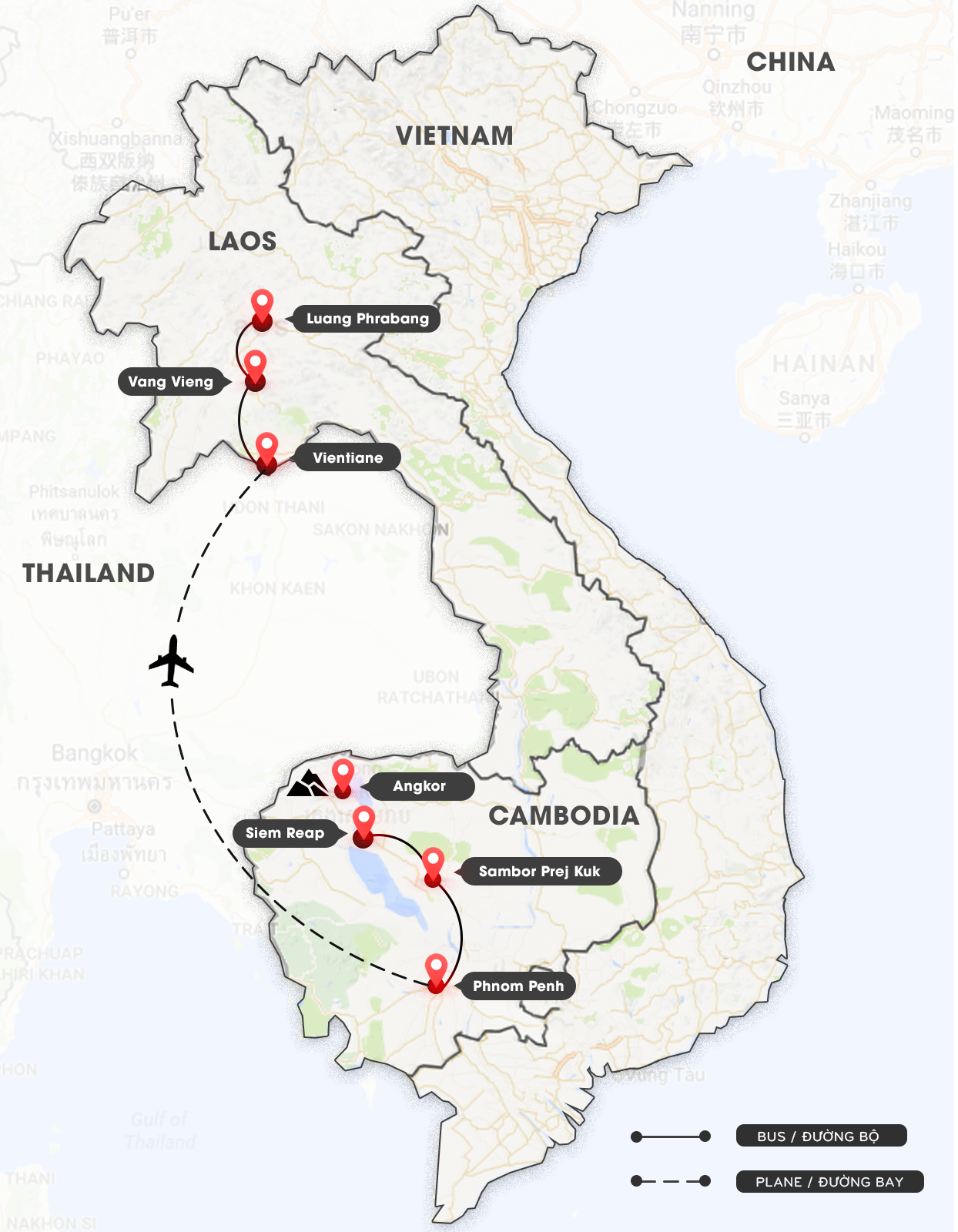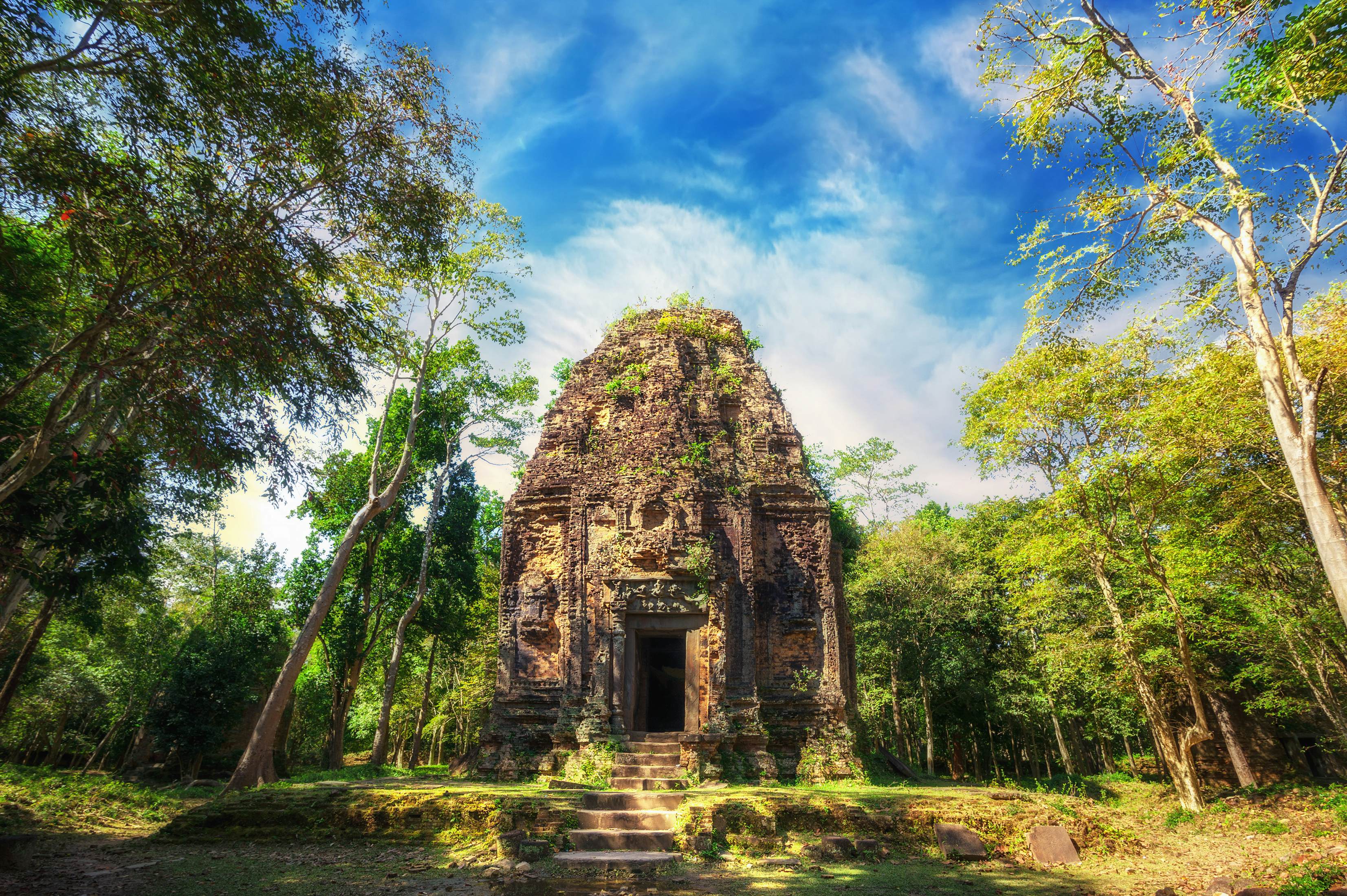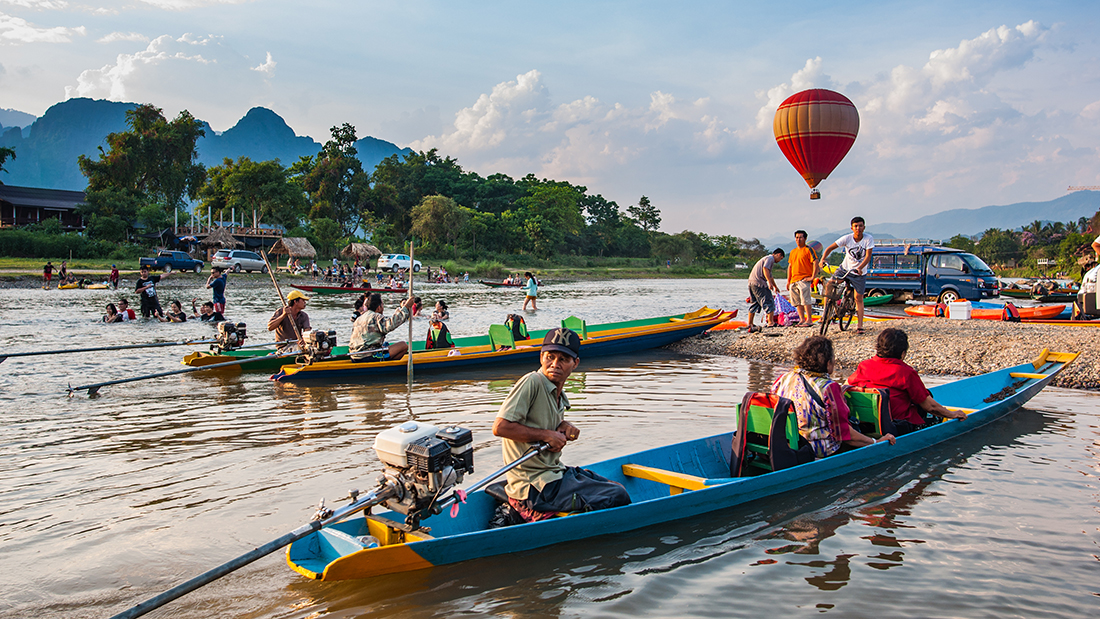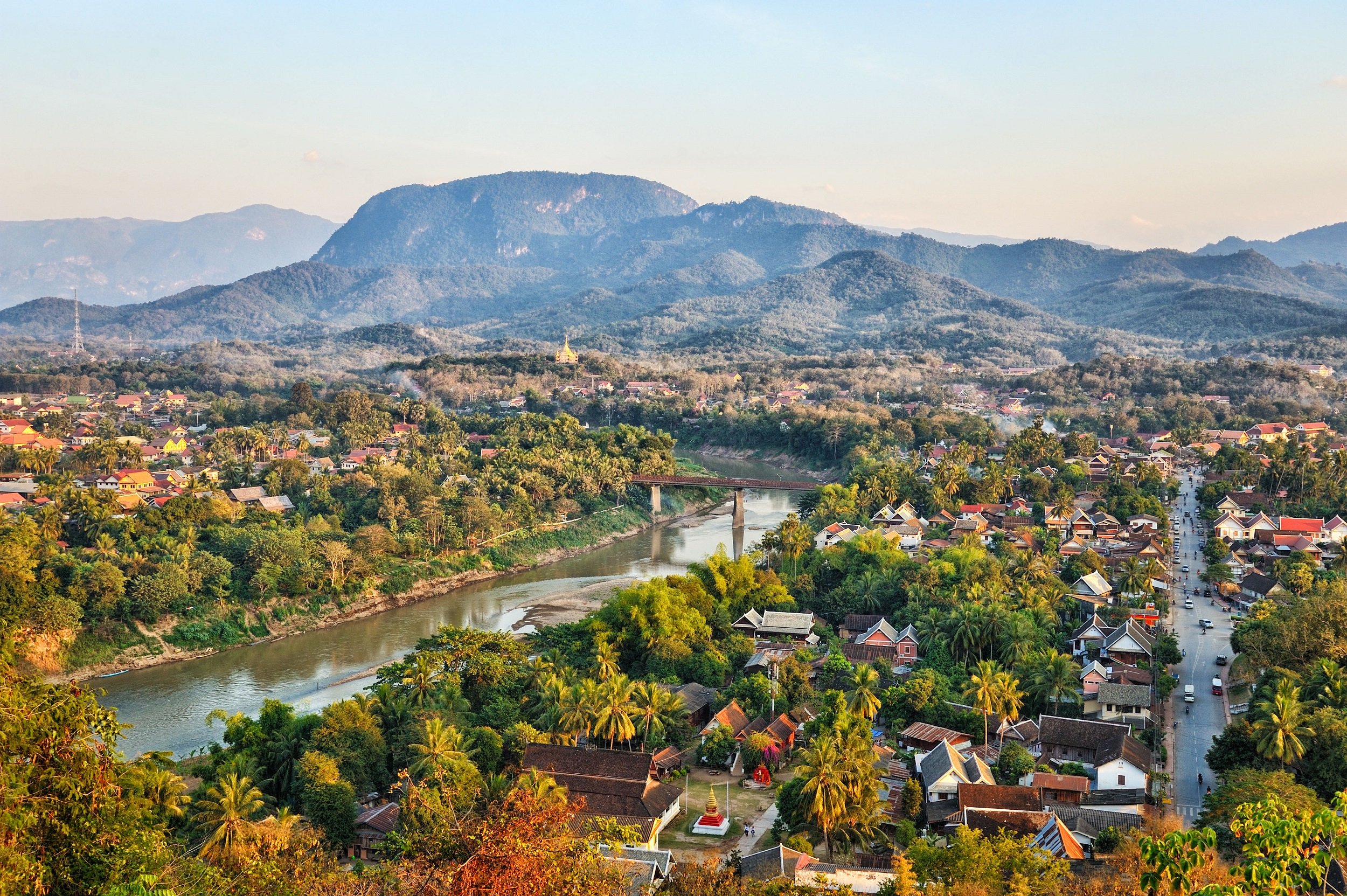Immerse yourself in the cultures of Cambodia and Laos on a 12-day tour through these beautiful countries. Explore the incredible Angkor complex, experience rural life with a local family, admire the French-style architecture of Phnom Penh and pay your respects with a visit to the Killing Fields. Then head to Laos and tour the breathtaking scenery around Vang Vieng before finishing up in the atmospheric city of Luang Prabang.
Overview
Highlights
Combining two great countries in a two-week trip, you'll discover the best of both worlds, from Cambodia's incredible Khmer temples to Laos' relaxed riverside beauty.
Angkor Wat. Need we say more? As well as a guided tour, you’ll also have a pass to cover your whole time in Siem Reap so you can explore this incredible temple complex as much and as often as you like.
Discover the temple ruins at Sambor Prei Kuk and enjoy a village homestay to experience everyday life in rural Cambodia.Discover the splendour of Vang Vieng's limestone landscapes. Your cycling and hiking excursion takes you to a stunning hidden waterfall via an ethnic tribal village

Itinerary
-
Day 1: Siem Reap
Sua s'dei! Welcome to Cambodia. Your adventure begins with a welcome meeting. Siem Reap is the gateway to Angkor Wat, but it's not without its own charms.
-
Day 2: Siem Reap - Angkor Wat
Today you'll visit the world-famous Angkor complex with your guide. The ruins are scattered over an area of some 160 square kilometres; this is the biggest religious monument in the world. However, the main cluster of temples is close to Siem Reap, so you'll have plenty of time to fully appreciate the mind-blowing archaeological sites of Angkor Wat (the astounding main attraction), the Bayon (a marvel of many sculpted decorations) and Ta Prohm (the eerily beautiful temples covered in jungle).
-
Day 3: Siem Reap
Enjoy free time in Siem Reap today. If you feel like some adventure, you can take the optional Angkor zip-line course, which gives you a bird's eye view of the rainforest, plus an adrenaline rush! Other options here include a visit to the sobering Landmine Museum – it's located a little further afield but is well worth the journey. In the evening you might want to see Phare the Cambodian Circus. Coming from vulnerable households, the perform ers have gained international recognition through their art practice. Like a Cambodian Cirque Du Soleil, modern Khmer tales mix theatre, music, dance, acrobatics, juggling, aerial acts, and contortion.
-
Day 4: Sambor Prei Kuk
Travel by private bus to Sambor Prei Kuk and your homestay (approximately 3.5 hours). You will embark on a tour of the village with your local guide. The guide will introduce you to the way of life of the local people, your homestay facilities and your hosts for tonight. Facilities are simple at your homestay, but this is a fantastic opportunity to experience everyday life in rural Cambodia. The temple ruins at Sambor Prei Kuk just nearby are some of the oldest in the country (dating back to the 6th century) and are well worth a visit. In the evening, relax and unwind as you enjoy a traditional Khmer dinner with your host family.
-
Day 5: Phnom Penh
After breakfast, leave the village and travel to Phnom Penh in a private minibus (approximately 4 hours). Cambodia's capital is set on a major junction of the Mekong and Tonle Sap rivers and boasts some fine examples of French-influenced architecture. This afternoon, enjoy some activities. Explore Wat Phnom, a peaceful temple situated on a local hill. A great way to see the city's key landmarks is a cyclo tour, which generally covers the central market, US Embassy, Wat Phnom, Mekong river front, Independence Monument and Royal Palace. The National Museum, housed in a beautiful traditional building, is a great place to see some excellent Khmer craftsmanship.
-
Day 6: Vientiane
This morning you will learn about Cambodia's tragic past on a guided tour of the Tuol Sleng Genocide Museum, a former school which served as a Khmer Rouge torture centre. Afterwards, head out to the Choeung Ek Memorial, where a stupa made up of some 8,000 human skulls marks the site of the infamous Killing Fields. This was the execution ground for the torture victims of Tuol Sleng. In the afternoon there will be some free time for optional activities. You might like to simply stroll along the famous Sisowath Quay and enjoy a coffee or cocktail at one of the many cafes while observing the busy river traffic. Then it's time for your flight to Vientiane (approximately 1.5 hours). Possibly Asia's most laid-back capital, Vientiane is a city where daily affairs are conducted at a relaxed pace. It also has an excellent, diverse food scene.
-
Day 7: Vientiane
Enjoy a guided walk around town this morning. Pay a visit to Wat Si Saket, a Buddhist temple believed to be the oldest still standing in Vientiane. You'll also see Victory Gate (Patuxai), otherwise known as the 'Vertical Runway' (as the US funds that were used to construct it were actually meant for airport upgrades). Climb up to the seventh storey for a nice view over Vientiane. Also stop in at COPE, an Intrepid Foundation-sponsored organisation that rehabilitates children who have been injured by unexploded ordnance. This is an excellent cause and a chance to learn more about Laos' devastating war history.
-
Day 8: Vang Vieng
Make the journey by public bus to Vang Vieng (approximately 3.5 hours). En route, take in scenes of small village life at various points along the hilly highway. When you arrive, you'll be greeted by stunning limestone karst scenery. These surrounding landscapes are the reason this town is known for its outdoor adventure culture. There are many fascinating caves to explore, some of which you can go swimming in. The classic Vang Vieng activity is to float down the lovely Nam Song on an old inflatable tractor tube. Hiking and cycling are all great ways to see the surrounding country.
-
Day 9 Vang Vieng
Set out on a bicycle today for an adventure further afield (around 15 kilometres). Along the way you'll stop in at a Khmu or Hmong village. The Khmu and Hmong are some of the most populous ethnic peoples in Laos and the majority of them live in the north of the country.Between May and January we head east out of the city for around 7 kilometres, then take a short trek (approximately 20 minutes) to the breathtaking Keng Yui waterfall. This is a great chance to relax and cool off with a refreshing swim.
-
Day 10: Luang Prabang
Today you will journey by private bus, winding your way through the beautiful mountains to Luang Prabang (approximately 8 hours). The scenery is especially amazing on this leg of the journey – a reward for enduring the windy roads! When you arrive, stretch your legs and take a walk to acquaint yourself with this exotic city. It's located at the confluence of the Mekong and Khan rivers. Luang Prabang's French colonial architecture, ornate Buddhist temples, unique markets and riverside ambience make for quite a combination.
-
Day 11: Luang Prabang
Enjoy a guided tour around the Traditional Art & Ethnology Centre, a local non-profit museum dedicated to preserving Laos' many ethnic tribal cultures. You will also head out of town to the beautiful Kuang Si Falls, where pale turquoise waters cascade over limestone formations. The lovely pool at the base of the falls is perfect for an afternoon swim. For those who are more active, it is possible to leave early and trek to the waterfall (there will be an additional cost for the transport, village fee and local guide). If the timing's right, you might catch feeding time at the Tat Kuang Si Bear Rescue Centre. The centre has been set up to protect, preserve and enrich the lives of Asiatic bears who have been rescued from trafficking.
-
Day 12: Departure
It is time to say “Good bye”. Transfer to the airport for your flight.


.jpg)








